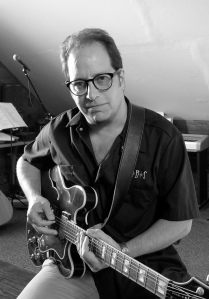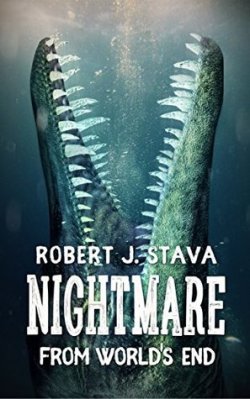Today I am happy to have Robert Stava on The Scary Reviews for an interview on the heels of his latest book. Robert Stava’s new novel couldn’t sound like more fun. The following is an excerpt from the full synopsis – In the aftermath of a major hurricane, a massive antique crate washes up on the shore of Raadsel Point. It’s smuggled cargo from the wreck of the Edmund Wood, an unregistered transport returning from a very unusual expedition. . . a ship that went down in the deepest and most dangerous part of the Hudson known as ‘The World’s End’. The nightmare creature it contains is about to unleash havoc on the citizens of the sleepy river village of Wyvern Falls and inadvertently draw to it a predator thought extinct a millennia ago.”
His fourth novel, “Nightmare at World’s End” was published in November 2016 by Severed Press. His short stories have been featured in anthologies from Dark Chapter Press, Nielsen Press and Sanitarium Magazine, and his first Y/A novella, “The Devil’s Engine”, was published by Muzzleland Press in 2015. He has several new stories slated for release in 2017, including a new novel “The Lost World of Kharamu” through Severed Press. It was really cool to talk to Robert about his love of writing and learn where the idea for his new book came from.

The Scary Reviews: Thank you so much for agreeing to this interview! For those who may be unfamiliar with your work, how did you first get started in writing and what led you to pursue it professionally?
Robert Stava: Like these things often do, it chose me, not the other way around. I’d dabbled with writing stories since high school and when I began a career in Advertising at Young & Rubicam I went as far as designing some mocked up book covers. But it wasn’t until nearly 20 years later I wrote the whole novel to go with one of them, “At Van Eyckmann’s Request”. That was six years ago. Since then I’ve been writing non-stop. It may be attributed to the infusion of oxygen after moving from NYC up into the Hudson Valley…or something else. Washington Irving talked about the ‘witching influence of the air’ up here, and I suspect he might have been right. Either way it’s been a passion of mine since. Especially when you drop into the ‘zone’. At that point, you’re no longer writing, your transcribing. It’s a rush.
TSR: What is a typical day of writing like for you? Do you have a set process or is it something that varies depending on the day?
RS: I do most all my writing first thing in the morning, up into lunch. Afternoons & evenings are for editing & rewrites. I don’t have any specific goals, other than to write every single day. Holidays and weekends. I tend to research and incorporate it on the fly, so there’s occasional breaks in there, but I like to keep it all very fluid. I never outline, but do keep a ‘slush’ file for each story where I drop random ideas, bits of research and snippets of dialogue as they occur to me. I have no idea where much of this comes from. Sometimes I’m tapping personal experiences, but a lot of it just spontaneously pops into my head.
TSR: What was your inspiration for writing Nightmare from World’s End?
RS: As always, it starts with the “What if?” question with me. In this case, it began as an offhand remark by my wife. We were having lunch one day at the Ossining waterfront when I saw something way out on the river. It might have been a cormorant. I had my camera and took a zoomed shot – it came out like a blurred version of the classic Loch Ness monster – and showed it to my wife. Without thinking, she said “Oh! That’s Ossie!” That got the wheels turning. “What if it was?” Not long after while exploring the shoreline of the Hudson I stumbled on what appeared to be a massive crate, covered in barnacles and they went together like a jigsaw puzzle.

TSR: Is Nightmare from World’s End the first time you have written about a cryptid or sea creature? If so how did you enjoy creating a mythological creature?
RS: Definitely a first. I was a bit wary of deviating from the classic horror story territory I’d been plumbing happily until that point into something more suited to the SyFy Channel, but as I said before, you’re not always in control of these things. If you’re being sincere, you have to go where the story tells you it should. It always does, if you let it. The clincher was swinging by a certain yearly folk festival up here I was struck by the obvious equation: Ossie + Folk Festival = High Body Count? After that I knew it was going to be fun. Oh boy, was it!
TSR: Do you have a preference between the novel format and some of the shorter formats (short story, novella, flash fiction, etc)? What do you enjoy about each style of storytelling?
RS: Nope. I enjoy all of them. To date I’ve written around three flash fiction stories, a few dozen short stories, four novellas and seven novels. Each has its innate challenges. Is a single idea rich enough to be mined for an entire novel without turning reader’s eyelids into manhole covers? Can a complex tale be wedged into 2000 words or less? I think by embracing all these formats you broaden your skills. Flash fiction is a real challenge – sort of like the literary version of a bonsai tree. A short story is an expanded version of that – you still have to trim your words with care – while a novella is like a short story that got away from you a bit, refusing to stay in the fenced short-story corral. When you hit novel territory, all bets are off. You get to go whole hog.
TSR: What novel had the biggest impact on you as a writer and who are some of your favorite current writers that you recently started reading?
RS: That’s a toughie. Many of them do. But one I still think about a lot, even 12 years after reading it is Michael Crichton’s ‘State of Fear’. A very insightful look at the human race through recent history and how every generation has its epic phobias, like clockwork. Peter Straub’s “Koko” is up there too – he really opened my mind up about Jazz in that book. I didn’t really grasp what he meant until I ran across an amazing piano player in the West Village named Freddy Francis. The guy had magic in his hands. There’s a whole current bunch of writers out there doing fabulous stuff, especially in the horror genre. T. E. Grau, Adam Howe (brutally funny) and Michael Marshall Smith off the top of my head. I recently read a tale by Adam Nevill – Where Angels Come In” – which was arguably the creepiest horror story I ever read. It seeps dread. And John Llewellyn Probert’s books are wickedly funny and dark.
TSR: You have written several books in the horror genre, is there any type of genre you haven’t explored yet that you are interested in pursuing?
RS: Science Fiction. But I’m not sure I’m cut out for it or could contribute anything original.
TSR: If you could choose any writer to collaborate or talk about writing with, who would you choose and why?
RS: John Llewellyn Probert perhaps. We seem to share a love of out-there horror as well as old Hammer Films, and I like his sense of humor. He’s trouble, that one. Of course I’d love to sit around the fireside having a chat with Mr. King and Mr. Straub. That would be an evening to remember.
TSR: Thanks again for stopping by The Scary Reviews, Robert! I love a good creature horror story and I’m looking forward to reading Nightmare from World’s End. Is there anything else you’d like to let your readers know?
Yes – if you see a tentacle rising out of the Hudson River near you, run like hell. If you’re in a boat… good luck!
Great interview! I’m proud to call Robert a friend and absolutely love his work. I’m actually saving his latest for my holiday reading, after all the madness has subsided and I can just enjoy some quiet time with a monster.
LikeLiked by 1 person
Thanks! But I have to give all the credit to Robert for his great responses.
LikeLiked by 1 person
If you ever want to interview me on your blog, I’m all yours. 🙂
LikeLiked by 1 person
That sounds great to me
LikeLiked by 1 person
hit me up any time at huntershea1@gmail.com
LikeLiked by 1 person